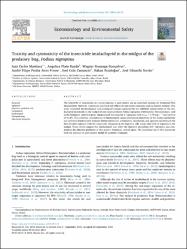Toxicity and cytotoxicity of the insecticide imidacloprid in the midgut of the predatory bug, Podisus nigrispinus

View/
Access
info:eu-repo/semantics/closedAccessDate
2019Author
Martinez, Luis CarlosPlata-Rueda, Angelica
Goncalves, Wagner Gonzaga
Penha Aires Freire, Andre Filipe
Zanuncio, Jose Cola
Bozdogan, Hakan
Serrao, Jose Eduardo
Metadata
Show full item recordAbstract
The selectivity of insecticides on natural enemies in pest control are an important strategy for Integrated Pest Management. However, insecticides can have side effects on non-target organisms such as natural enemies. This study evaluated the histological and cytological changes mediated by the sublethal concentration of the imidacloprid insecticide on the midgut of non-target predator Podisus nigrispinus (Heteroptera: Pentatomidae), used in the biological control of pests. Imidacloprid was toxic for P. nigrispinus with LC50 = 3.75 mg L-1 and survival of 51.8%. This sublethal concentration of imidacloprid causes histological alterations in the midgut epithelium and cytotoxic features were irregular border epithelium, cytoplasmic vacuolation, and apocrine secretions in the first 6 h after exposure with the insecticide. Apoptosis in the digestive cells occurs after 12 h of exposure in the midgut. These results suggest that imidacloprid may affect the digestive physiology of P. nigrispinus and compromise the effective predation of this insect a biological control agent. The associated use of this insecticide with the predator in pest control should be carefully evaluated.

















